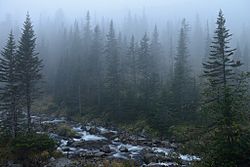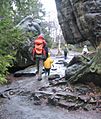Nature reserve facts for kids

A nature reserve is a special place where nature is protected. It's like a safe home for wildlife, which includes both plants (called flora) and animals (called fauna). In these areas, plants and animals are left alone to live without being disturbed by people.
Nature reserves can also protect interesting rock formations or other unique natural features. They offer great chances for scientists to study nature and do research.
Sometimes, governments in different countries manage nature reserves. Other times, private owners, like charities or research groups, create and run them. Nature reserves have different levels of protection, depending on the local laws and how important the area is for conservation. These levels are set by groups like the IUCN.
Contents
Why Nature Reserves Are Important
Nature reserves play a very important role in protecting our planet. They help keep many different kinds of plants and animals safe from harm. Without these protected areas, many species could disappear forever.
Protecting Animals and Plants
Nature reserves are like safe havens for animals. They provide a place where animals can find food, water, and shelter without being hunted or having their homes destroyed. This helps many species survive and thrive.
They also protect many types of plants, from tiny wildflowers to tall trees. These plants are important for the environment and for the animals that depend on them for food and shelter.
Studying Nature
Scientists love nature reserves because they are perfect outdoor classrooms. Researchers can visit these areas to study how plants and animals live and interact. This helps us learn more about the natural world and how to protect it better.
How Nature Reserves Are Made
Nature reserves can be created in different ways. Sometimes, a government decides to protect a certain area because it has special plants, animals, or landscapes. Other times, groups of people or charities buy land to turn it into a reserve.
Who Manages Them
Many nature reserves are managed by government agencies. These agencies make rules to protect the land and its wildlife. They also hire park rangers and scientists to look after the reserve.
Some reserves are run by private groups or charities. These groups often rely on donations and volunteers to help them protect the land. They work hard to make sure the reserve stays a safe place for nature.
History of Nature Reserves
The idea of protecting natural areas is not new. People have wanted to save special places for a long time.
The First Reserve
One of the very first nature reserves was created in 1821 by a man named Charles Waterton. He was an English explorer and naturalist. He turned his family estate, called Walton Hall, into a wildlife sanctuary. He built a tall wall around it to keep out poachers and protect the animals living there. This was a big step towards modern nature reserves.
Growing Around the World
Over time, more and more countries started to create their own nature reserves and national parks. These protected areas became very important for saving nature as human populations grew and spread. Today, there are thousands of nature reserves all over the world, protecting all kinds of environments, from forests and mountains to wetlands and deserts.
Images for kids
-
The Bee Lick Creek, of the Jefferson Memorial Forest, was designated as a National Audubon Society wildlife refuge.
-
A forest of the Aulanko Reserve in Hämeenlinna, Tavastia Proper, Finland
-
A bridged stone river in Bistrishko Branishte, an early Bulgarian nature reserve established in 1934.
-
The Tarvasjõgi river at Põhja-Kõrvemaa Nature Reserve in Estonia
-
Nature reserve near Budapest, next to Lake Naplás
-
Peñas Blancas, part of the Bosawás Biosphere Reserve is the second largest rainforest in the Western Hemisphere, after the Amazonian Rainforest in Brazil. Located northeast of the city of Jinotega in Northeastern Nicaragua.
-
Cascade Head, Oregon, United States, is a UNESCO biosphere reserve
See also
 In Spanish: Reserva natural para niños
In Spanish: Reserva natural para niños















